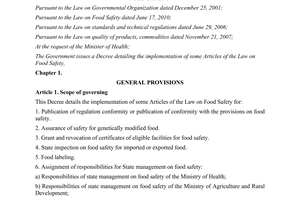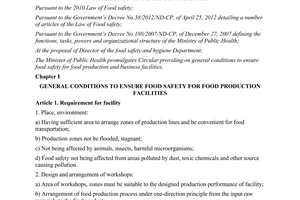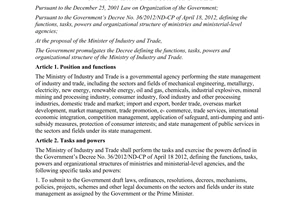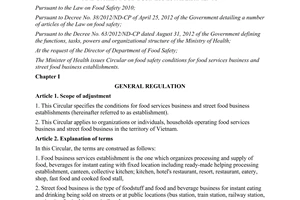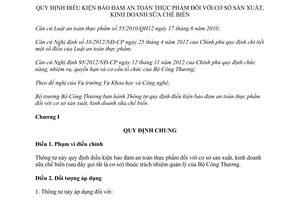Circular No. 54/2014/TT-BCT conditions for food safety assurance for processed milk production đã được thay thế bởi Circular 27/2016/TT-BCT abrogation legislative documents regulatory requirements for investment và được áp dụng kể từ ngày 20/01/2017.
Nội dung toàn văn Circular No. 54/2014/TT-BCT conditions for food safety assurance for processed milk production
|
THE MINISTRY OF
INDUSTRY AND TRADE |
THE SOCIALIST
REPUBLIC OF VIETNAM |
|
No. 54/2014/TT-BCT |
Hanoi, December 18, 2014 |
CIRCULAR
PRESCRIBING CONDITIONS FOR FOOD SAFETY ASSURANCE FOR PROCESSED MILK PRODUCTION AND TRADING ESTABLISHMENTS
Pursuant to June 17, 2010 Law No. 55/2010/QH12 on Food Safety;
Pursuant to the Government’s Decree No. 38/2012/ND-CP of April 25, 2012, detailing a number of articles of the Law on Food Safety;
Pursuant to the Government’s Decree No. 95/2012/ND-CP of November 12, 2012, defining the functions, tasks, powers and organizational structure of the Ministry of Industry and Trade;
At the proposal of the Director of the Department of Science and Technology;
The Minister of Industry and Trade promulgates the Circular providing conditions for food safety assurance for processed milk production and trading establishments.
Chapter I
GENERAL PROVISIONS
Article 1. Scope of regulation
This Circular prescribes food safety assurance conditions for processed milk production and trading establishments (below referred to as establishments) managed by the Ministry of Industry and Trade.
Article 2. Subjects of application
1. This Circular applies to:
a/ Processed milk production and trading establishments;
b/ Competent state management agencies and organizations and individuals involved in the production and trading of processed milk.
2. This Circular does not apply to:
a/ Small-scale processed milk production and trading establishments;
b/ Street catering service providers and street food vendors governed by the Ministry of Health’s Circular No. 30/2012/TT-BYT of December 5, 2012, providing food safety conditions for street catering service providers and street food vendors.
Article 3. Interpretation of terms
In this Circular, the terms below are construed as follows:
1. Processed milk production establishment covers all physical foundations, workshops, machinery, equipment and environmental conditions for producing processed milk products.
2. Processed milk trading establishment means an establishment that introduces, preserves, transports, purchases and sells processed milk products.
3. Processed mild product means a product which is processed from animal milk, with or without added nutrients, food additives, flavors or vitamins.
4. Small-scale processed milk production or trading establishment means an establishment which is registered as a business household by an individual, a group of individuals or a household and not granted a business registration certificate, enterprise registration certificate or investment certificate as prescribed by law.
Article 4. General provisions applicable to processed milk production or trading establishments
Processed milk production or trading establishments shall comply with the Ministry of Health’s Circular No. 15/2012/TT-BYT of September 12, 2012, providing general conditions for food safety assurance for food producers and traders, and the provisions of this Circular.
Chapter II
CONDITIONS FOR FOOD SAFETY ASSURANCE FOR PRODUCTION ESTABLISHMENTS
Article 5. Processed milk production establishments
1. Production site
a/ To be built under the current master plan approved by a competent state agency;
b/ To be situated far from sources of pollution or hazards and not be affected by pollutants from the surrounding environment on the quality and safety of processed milk products;
c/ To have sufficient space for arranging production lines suitable to the establishment’s design capacity, ensuring that technology requirements are satisfied and industrial sanitation measures are applied at all production stages.
2. Workshop layout and design
a/ The production line shall be located in an area not affected by sources of pollution such as steam boilers, wastewater treatment facilities, solid waste collection sites and toilets;
b/ Workshops shall be designed according to the one-way rule from input materials to final products which are processed milk of all kinds;
c/ Raw material warehouses; supplies and packaging warehouses; final product warehouses; production areas (material preparation; processing; filling and packaging and product finishing; clean-in-place systems; mechanical and power systems); chemical warehouses; solid waste collection sites and wastewater collection systems; and other auxiliary works must be separated from one another to avoid cross-contamination;
d/ Internal roads shall be designed and built in a way that ensures solidity, durability and suppression of dust; overhead walkways shall be installed with handrails or partitions which facilitate observation and ensure occupational safety;
dd/ Water drainage systems (for wastewater generated from production and daily-life activities and rainwater) shall be designed and built separately, have covers and a suitable slope to ensure complete drainage.
3. Workshop structure
a/ The ground of production areas must facilitate water drainage and shall be built of durable, difficult-to-peel-off, anti-slip and easily cleanable materials. Water drainage systems in production areas must have covers;
b/ Catch pits must have traps to prevent sewer odor and insects and restrict the penetration of microorganisms from sewer systems into workshops;
c/ Pipe systems shall be designed and manufactured of suitable materials and painted in different colors and must have distinguishable characteristics.
4. Ventilation system
a/ Workshops must have ventilation doors to ensure air circulation and facilitate the dissipation of heat and exhaust generated from production activities; in case of forced ventilation, air conditioning equipment must provide sufficient fresh air and ensure air circulation;
b/ The area where the filling line is installed must always be kept dry, well ventilated and clean.
5. Water supply and storage system
a/ To supply sufficient quality water;
b/ There must be sufficient pump systems, water treatment systems, water tanks and water pipe systems, which are always in good condition and regularly inspected to prevent backflow and blockage;
c/ Water supply systems must be separate, have noticeable signs, and be easy to clean so as to ensure safety of the clean water source and avoid contamination;
d/ Water tanks, settling tanks and filtration tanks must fit water treatment technology and shall be cleaned according to regulations or when necessary;
dd/ Upon occurrence of an incident related to water quality, production shall be immediately stopped and products produced during the occurrence of the incident shall be isolated;
e/ There must be standby electricity generators and water pumps so as to ensure uninterrupted production in case of power outage or water pump failures;
g/ After being treated up to standards applicable to milk production, water shall be stored and preserved so as to avoid contamination from sources of pollution.
6. Steam, heat and compressed air supply systems
a/ Steam boilers shall be designed and made of suitable materials, installed in places separated from production areas and regularly inspected according to current regulations;
b/ Steam and compressed air pipe systems shall be designed and made of suitable materials, securely installed, and easily distinguished from other pipe systems, and regularly inspected according to current regulations.
7. Waste, wastewater and exhaust gas collection and treatment systems a/ For solid wastes
- Solid wastes shall be collected and put in suitable tanks or containers put in places convenient for waste collection and treatment without causing adverse impacts to the production process;
- Scrap containers shall be clearly labeled or have signs for distinction from containers of raw materials, semi-finished products and finished products; be made of waterproof and corrosion-resistant materials; be tight and easy to clean (for reusable containers) or easy to destroy (for disposable containers);
- Solid wastes shall be treated by organizations or individuals licensed to operate in the field of environmental treatment by competent state management agencies.
b/ For industrial and daily-life wastewater
- Wastewater treatment facilities shall be located separately from production areas;
- Wastewater treatment capacity and technologies must suit the peak discharge so as to ensure that treated wastewater is up to prescribed environmental standards;
- It is not permitted to directly discharge untreated wastewater into the surrounding environment; drains in production areas must run from clean to less clean areas and ensure complete drainage even when the water flow stops;
- Catch pits must have lids; drains and catch pits in production areas shall be cleaned at the end of each workday and regularly dredged according to regulations.
c/ Exhaust gas from a production area and steam boilers shall be treated so as to cause no adverse impacts to other production areas.
d/ Hazardous wastes
- Hazardous wastes shall be collected, stored, transported and treated separately according to current regulations;
- Hazardous wastes shall be managed and treated by organizations and individuals licensed to treat hazardous wastes by competent state management agencies.
8. Warehouse system
a/ Raw material and additive warehouses
- Raw material and additive warehouses shall be separated from production areas;
- Raw materials and additives shall be placed in shelves or stands and kept away from direct sunlight;
- Raw material and additive warehouses must satisfy temperature, moisture, storage duration and other conditions as instructed or required by manufacturers;
- Raw materials and additives which have their sacks opened but have not yet been used up shall be securely closed after each use and stored according to regulations;
- Raw materials and additives stored in warehouses must have information on their names and use duration;
- Raw milk warehouses: Milk purchasing stations must have chilling systems and equipment, devices and chemicals to test the quality of raw milk, and must keep samples of purchased milk; raw milk tanks must have a heat- resistant layer and inner layer made of contamination-resistant materials that can maintain the temperature of 4oC-6oC; the storage period of raw milk, counting from the time of milking till the time of processing, must not exceed 48 hours; immediately after being used, milk tanks shall be cleaned to be free of microorganisms and chemical detergent residues according to regulations;
- Raw material and additive warehouses shall be regularly maintained and cleaned according to internal regulations;
- Only responsible or authorized persons may enter raw material warehouses.
b/ Supplies, packaging and chemical warehouses
- Supplies, packaging and chemical warehouses shall be located separately from production areas;
- Supplies and packaging shall be kept away from direct sunlight;
- Packaging in direct contact with products shall be stored according to regulations of manufacturers;
- The storage duration and other preservation conditions must comply with the instructions or regulations of manufacturers;
- Supplies, packaging and chemical warehouses shall be regularly maintained and cleaned according to internal regulations.
c/ Finished product warehouses
- Finished product warehouses shall be located separately from production areas and must be convenient for warehousing and ex- warehousing activities;
- Finished product warehouses shall always be kept at a certain temperature as required, be dry, clean and well ventilated and stored products shall be kept away from direct sunlight so as to avoid changes in their quality, appearance and safety;
- There must be a separate space for keeping substandard quality products pending disposal;
- Finished product warehouses shall be regularly maintained and cleaned according to internal regulations;
- Products stored in finished product warehouses must have information on their name, lot number, date of manufacture, production shift and use duration;
- For products which require cold preservation:
+ Products shall be stored in refrigerated warehouses, ensuring that cold air is always distributed to every corner of the warehouses;
+ Refrigerated warehouses shall always be kept at a certain temperature as required for each type of product.
9. Production areas
a/ Raw material preparation area
- Raw materials shall be sorted by type and put in shelves or stands;
- Flavorings shall be prepared separately so as to avoid cross- contamination;
- Measuring devices must operate accurately and properly;
- The area shall be regularly cleaned to avoid dust and stagnant water;
- Only responsible or authorized persons may enter the area where raw materials are handed over for production.
b/ Processing area
- Processing equipment shall be cleaned before each production circle every day;
- Rubbish shall be collected in plastic bags placed at designated places;
- Persons working in the material mixing or blending area who are in direct contact with products shall wear waterproof, durable, light-colored and food-safe gloves;
- The area shall be cleaned every day or after each production cycle of each type of product;
- Only responsible or authorized persons may enter the area to avoid cross-contamination.
c/ Filling and packaging area
- The chambers where filling lines are located must be closed, aseptic and kept at 20oC-28oC with a positive air pressure relative to the outside;
- Filling equipment must be aseptic during the filling process;
- The inner surface of the pipes conducting products to filling equipment shall be disinfected according to regulations;
- Filling equipment shall be cleaned every day or after each production cycle of each type of product;
- Only responsible or authorized persons may enter the area to avoid cross-contamination.
d/ Finished product area
- The milk product packaging area shall be cleaned before the packaging takes place and always kept dry.
- Devices and equipment for packing finished milk products (thin-film packaging machines, are duration printers, carton filling conveyors) shall be well cleaned.
10. Internal transportation
a/ Establishment owners shall specify (in writing) requirements on vehicles for, and mode of, internal transportation of processed milk products as well as preservation conditions and food safety management during internal transportation;
b/ Processed milk products may not be transported in the same tanks or vehicles with supplies, raw materials and chemicals as this might cause cross contamination affecting the quality and safety of the products.
11. Raw material and product quality control systems
a/ Quality control areas shall be situated separately and conveniently for controlling the quality in the production process; be equipped with essential machinery, equipment and instruments to measure and inspect basic quality criteria of major raw materials and finished products. Microorganism testing sections must be aseptic and isolated from other testing sections;
b/ If having no quality control sections, establishments shall outsource the control of basic quality criteria of major raw materials and finished products to inspection and analysis organizations that have suitable professional capacity and qualifications;
c/ There must be places for preserving samples and keeping dossiers of preserved samples. Establishments shall comply with regulations on sample preservation and destruction applicable to each type of sample.
12. Management of records
a/ Establishments shall keep sufficient management records (contracts, invoices, documents, quality testing slips, regulation conformity announcement dossiers, food safety regulation-conformity announcement
dossiers and other relevant documents) for raw materials, auxiliary materials, additives, processing aids, supplies, packages and chemicals to serve origin tracing and food safety and quality control;
b/ Establishments must have sufficient food safety management records according to regulations (certificates of satisfaction of food safety conditions, receipts of regulation conformity announcements or written certifications of food safety regulation-conformity announcements) for their processed milk products.
Article 6. Equipment, packaging and containers of processed milk
1. Equipment, packaging and containers in direct contact with processed milk products must comply with the Ministry of Health’s Circular No. 34/2011/TT-BYT of August 30, 2011, promulgating national technical regulations on safety and sanitation of packaging and equipment in direct contact with food.
2. Machinery, equipment and utensils in contact with milk and raw materials shall be synchronously designed and manufactured, made of rustless materials, do not cause harms when being used for the intended purpose, and can be easily cleaned, disinfected and maintained whenever necessary so as to avoid contamination.
3. Equipment for heat-treating, cooling, chilling, and refrigerated storage of, milk shall be designed in a way that can quickly reach and maintain the necessary temperature; and ensure the monitoring and control of temperature as required.
4. Air blown directly to products (if any) must be aseptic.
5. There must be alarm systems which sound when technical parameters (temperature, pressure) exceed prescribed levels.
6. Waste and hazardous chemical containers shall be designed in a suitable manner to ensure safety and noticeability, and be made of durable materials.
7. Production, processing and testing equipment and devices shall be regularly maintained and replaced when damaged or showing signs of damage.
Testing and measuring devices and equipment subject to strict safety requirements shall be calibrated and inspected according to regulations.
8. The repair and maintenance of devices, equipment and machinery shall only be conducted outside production areas or when production activities have stopped. In case of on-site repair or regular maintenance of devices, equipment and machines, such devices, equipment and machines shall be cleaned as soon as the repair or maintenance finishes.
9. Lubricant oils and greases used for equipment and machinery in direct contact with products must be those permitted for use in food production.
Article 7. Establishment owners, workers directly engaged in production and visitors
1. Establishment owners and workers directly engaged in production must possess valid certificates of food safety knowledge granted by functional agencies or units designated by competent authorities.
2. Annually, establishment owners shall arrange at least one medical check-up for themselves and workers directly engaged in production at a medical establishment of district or higher level. Health records of these persons shall be kept at establishments.
3. To recruit only those who meet the Ministry of Health-prescribed health criteria for persons directly engaged in food production and processing.
4. When a person directly engaged in production contracts a disease, he/she shall report to competent persons so that he/he shall be assigned to perform other jobs or be allowed to take a leave for medical treatment according to regulations. Such person may return to work only after obtaining a certificate of full recovery and satisfaction of health requirements for food production and processing jobs from a competent health agency.
5. Persons directly engaged in production and processing shall keep all parts of their bodies clean and, before starting to work, wear protective clothes suitable to their working positions.
6. Visitors shall wear protective clothes and follow establishments’ personal hygiene regulations.
Chapter III
FOOD SAFETY ASSURANCE CONDITIONS FOR PROCESSED MILK-TRADING ESTABLISHMENTS
Article 8. Processed milk-trading establishments
1. Product display, preservation and storage areas must always be dry and clean so as to ensure that properties of products are kept unchanged and products are not contaminated with hazardous chemicals, impurities or microorganisms harmful to consumer health.
2. To comply with producers’ instructions on product storage.
3. To work out cleaning processes and keep a cleaning diary as instructed by establishment owners.
Article 9. Devices and equipment serving the trading of processed milk
Trading establishments must have sufficient equipment and devices so as to meet temperature, moisture, light and other conditions as required by producers for each type of product during the storage and trading of processed milk products.
Article 10. Management of dossiers
Processed milk-trading establishments shall keep legal dossiers and documents evidencing the origin and quality of products to serve origin tracing and food safety and quality management.
Article 11. Transportation of processed milk
1. Processed milk-transporting vehicles must prevent the penetration of insects and contamination with sources of pollution and be easy to clean.
2. Milk products of different types shall be classified and arranged separately so as to meet producers’ preservation requirements during transportation.
3. Processed milk products must not be transported together with goods which are hazardous or might cause cross-contamination, affecting the quality and safety of milk products.
4. Milk product-transporting vehicles and containers during transportation shall be regularly cleaned.
5. Establishments shall work out internal regulations on conditions for food safety assurance during transportation.
Chapter IV
IMPLEMENTATION PROVISIONS
Article 12. Organization of implementation
1. The Department of Science and Technology shall assume the prime responsibility for, and coordinate with related agencies in, disseminating, and guiding the implementation of, this Circular nationwide.
2. Provincial-level Industry and Trade Departments shall guide and implement this Circular in their localities.
3. In the course of implementation, the Department of Science and Technology shall, when necessary, propose the Ministry of Industry and Trade to amend and supplement this Circular based on management requirements and practical situation.
Article 13. Effect
This Circular takes effect on February 3, 2015.-
|
|
FOR THE
MINISTER OF INDUSTRY AND TRADE |

